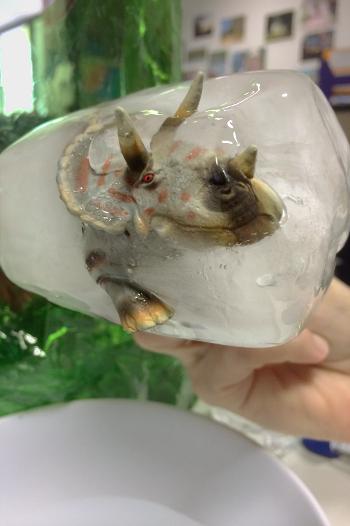Ice surprise
Duration/age

Children delight in finding surprises and these blocks are a way of keeping your child interested as they try to free the surprise in the iceblock.
Partially fill a milk carton or small plastic container with water. Add a plastic creature or other surprise such as a shell, leaves or even flowers. Freeze it overnight and turn out the iceblock in the morning. Talk to your child about the different ways they could free the surprise.
How can you get the surprise out of the iceblock?
Your child could use an eye-dropper or a turkey baster to drip water on the ice and free the surprise.
What other ways can you think of to get the surprise out of the iceblock? What will happen if you put some salt on the ice?
If you can make a few iceblocks in one go, your child could use them as building blocks.
Materials you will need
- Water
- Milk cartons
- Small containers
- Surprises
- Freezer
- Eye-dropper
Alternative tools
- Salt
- Turkey baster
Skills this activity improves
Why does this matter?
When children are playing with ice like this they will be exploring and experimenting as they figure out how to free the surprises. They will be predicting what might happen and how long it might take to do.
They will be watching and observing as the iceblock changes and melts and if you talk to your child about what is happening you will be helping them to build a vocabulary.
Planning how to get the surprises out of the iceblock helps children to think logically and try different approaches.
Using tools like eyedroppers helps children to develop their small or fine muscles.
What does this lead to?
Exploring and experimenting helps children to come up with and test hypotheses. The ‘what-if’ way of thinking is an important learning skill.
Having a wide vocabulary also helps children when they are reading and talking with others.
Being able to plan helps children to be organised and to work with others.
Developing fine motor skills helps children with drawing and writing.
Language to use
- Ice, wet, melt, frozen, water
- Cold, warmer, warm
- Outside, inside
- Drip, drop
Questions to use
- How long do you think it will take to melt the iceblock?
- What could you use to hurry it up?
- What do you think will be inside?
- I can see a foot. Whose foot could that be?
Useful tips
- You might also like to look at the activity A big block of ice
- If you are doing this activity inside you can put the iceblocks on a tray or plate to catch the water.
- Remember to only freeze the water in open or unsealed containers, as water expands as it freezes.
- Remember to talk to your child in your home language.
More ideas
- Use a small amount of food colouring to make coloured surprise iceblocks. This might make it harder to see what is inside the iceblock. A real surprise!
- Make the iceblocks with your child. While it won’t be as much of a surprise this is a good opportunity to talk about freezing water.
Variation by age
Three to five year olds
- You could make some ice sculptures. Freeze water in containers that are different shapes and sizes. You could use things like muffin tins, yoghurt tubs and cake tins. Put a little food colouring into some of the containers. When the iceblocks are frozen turn them out and build with them.
- Try a little archaeology. Bury some treasures in different places and try to find them. It could be in your sandpit, in the garden, in playdough or even in a big box of rice. Help your child to find the treasures. Maybe they will need some clues to help with the search. In the sand or garden you could use archaeological tools like small trowels and brushes.
- Visit your local library and find some books about dinosaur bones and fossils.
Questions to ask
- Can you balance the blocks to make a sculpture?
- Which one will go on top?
Language to use
- Balance, build, tower
- Shape
- Small, smaller, bigger, biggest
- Red, green, yellow, blue
- Translucent, transparent
- Slippery
- Dig, bury, find
- Gentle, soft
- Bones, fossils


